Types, Advantages, Disadvantages - Classification of Cooking Methods | 11th Nutrition and Dietetics : Chapter 1 : Introduction to Food
Chapter: 11th Nutrition and Dietetics : Chapter 1 : Introduction to Food
Classification of Cooking Methods
Classification
of Cooking Methods
The methods of cooking
are classified as given in table 1.1
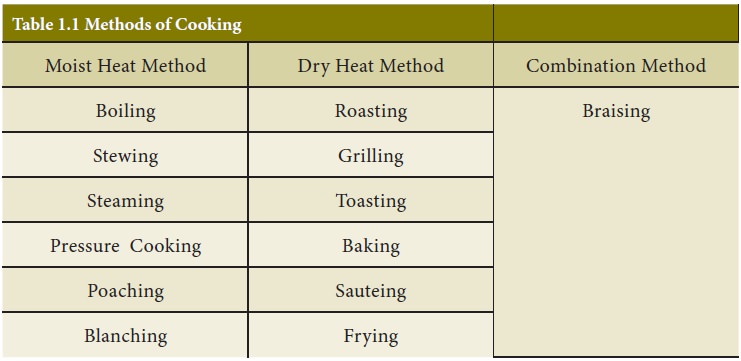
a. MOIST HEAT METHOD
In this method, food
comes in contact with moisture either by water or steam under pressure. Some
common ways of cooking food by moist heat are described below.
1. Boiling
Boiling is cooking
foods in a liquid (water, bouillon, stock, milk) at boiling point. Boiling is a
method of cooking foods by just immersing them in water at 100 ºC and
maintaining water at the temperature till food is tender. Rice, egg, dhal,
meat, roots and tubers are cooked by boiling method.
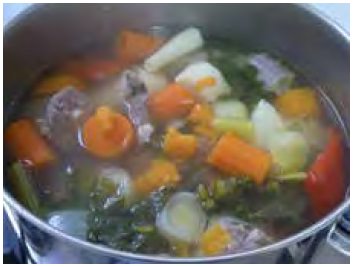
Advantages
·
Boiling is a safe and simple method of cooking.
·
It is suitable for large scale cooking. Boiled food is also
digested easily
Disadvantages
·
While boiling, water soluble nutrients are lost if the water in
which the food is boiled is discarded. Some people may not like boiled food as
they find it bland.
2. Stewing
When food is cooked
with the heat from water vapors, it is called stewing. This method requires the
food to be cooked in steam. Stewing is a long and slow cooking method where
food is cut into pieces and cooked in the minimum amount of liquid, water,
stock or sauce. The food and the cooking liquid are served together. In this
slow method of cooking the liquid is heated to boiling point and heat is
reduced to maintain simmering temperatures (820 ºC – 900 ºC).
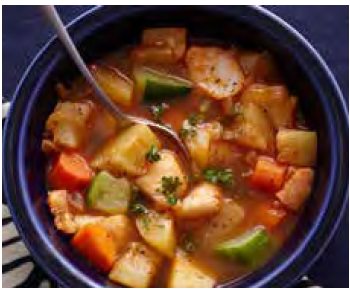
Advantages
·
In stewing, the juices of the food are retained and the food
tastes good.
·
The nutrients are also conserved better.
Disadvantages
·
Food takes longer to cook.
·
The process is time consuming and there is wastage of fuel.
3. Steaming:
It is a method of cooking
food in steam generated vigorously from boiling water in a pan. The food to be
steamed is placed in a container and is not in direct contact with the water or
liquid. Idli, custard and idiappam are made by steaming. Vegetables can also be
steamed.
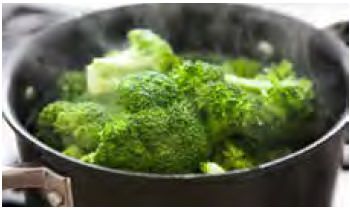
Advantages
·
Steaming shortens the duration of cooking and helps to conserve
·
nutritive value, colour, flavour and palatability of food.
·
Steamed food is light, nutritious and easy to digest. Such foods
are good, especially for people who are sick or people with weak digestion or
for the elderly. Young children can be served with steamed food.
Disadvantages
·
Steaming equipment is required.
·
This method is limited to the preparation of selected foods.
4. Pressure cooking :
When steam under
pressure is used, the method is known as pressure cooking and the equipment
used is the pressure cooker. In this method the temperature of boiling water
can be raised above 100 ºC. Rice, meat, roots and tubers are usually pressure
cooked.
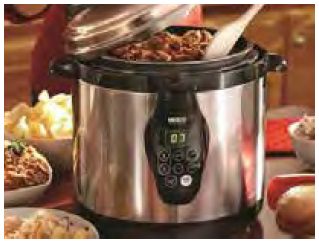
Advantages
·
Pressure cooking kills all bacteria and hence the food is safe
and hygienic to eat.
·
The food gets cooked faster i.e. almost 1/3rd time
than boiling.
·
Saves fuel, time and energy.
·
Several foods can be cooked together in the pressure cooker by
using separators.
·
It is not necessary to immerse food in water while cooking and
this reduces the loss of water soluble vitamins and minerals.
Disadvantages
·
If food is cooked for very long, it loses its texture and may
even burn.
·
Knowledge of the usage, care and maintenance of cooker is
required to prevent accidents.
·
Careful watch on the cooking time is required to prevent over
cooking.
5. Poaching:
This involves cooking
in minimum amount of liquid at temperatures of 800°C – 850°C that is below the
boiling point. Foods generally poached are egg, fish and fruits. For poaching
eggs, the addition of little salt or vinegar to the cooking liquid lowers
temperature of coagulation. Eggs get cooked quickly by poaching.
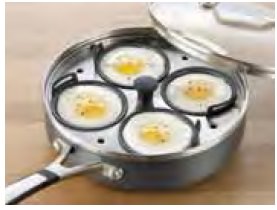
Advantages
·
A variety of liquids can be used (stock, wine, milk, syrup).
·
Liquid can improve flavor.
·
Food becomes more digestible.
·
Ideal for high-protein foods, eg. Fish
Disadvantages
·
Requires constant attention.
·
Range of suitable foods is limited.
·
Foods overcook quickly.
6. Blanching:
In meal preparation,
it is often necessary only to peel off the skin of fruits and vegetables
without making them tender. This can be achieved by blanching. eg. tomatoes can
be blanched in this method, food is dipped in boiling water for 5 seconds to 2
minutes depending on the texture of the food. This helps to remove the skin or
peel without softening food.
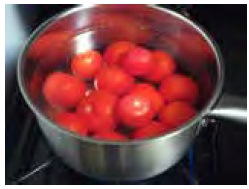
Advantages
·
Peels can easily be removed to improve digestibility.
·
Destroys enzymes that bring about spoilage.
·
Texture can be maintained while improving the colour and flavour
of food.
Disadvantage
·
Loss of nutrients if cooking water is discarded.
b. DRY HEAT METHOD
Dry heat cooking gives
a crisp texture, brown colour and pleasant flavor to the foods. Some common
ways by which you cook food by dry heat are described here.
1. Roasting:
This method of cooking
food by dry heat is roasting. While roasting, the food is subjected directly on
a hot tava or girdle or sand or fire and cooked. Eg. Groundnuts
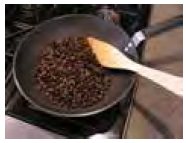
Advantages
·
Food is tastier when cooked in this way. It also adds variety to
a meal.
·
It improves the appearance, flavor and texture of the food.
·
Spices are easily powdered if they are first roasted.
Disadvantages
·
It is a relatively slow method of
·
cooking. Roasted food sometimes become too dry, therefore, it
may be served with a chutney or sauce.
·
Roasting denatures proteins reducing their availability.
2. Grilling:
Grilling or broiling
refers to the cooking of food by exposing it to direct heat. In this method food
is placed above or in between a red hot surface. Papads, corn, phulkas, chicken
can be prepared by this method.
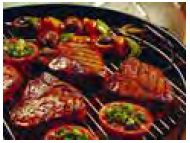
Advantages
·
Grilling like roasting also gives nice flavor to the food.
·
A variety of dishes can be prepared using this method.
Disadvantage
· Constant attention is required to prevent charring.
3. Toasting:
This is a method where
food is kept between two heated elements to facilitate browning on both sides.
Bread slices are cooked by toasting.Eg. sandwiches.
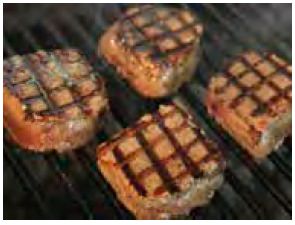
Advantages
·
Easy and quick method.
·
Flavour improved.
Disadvantages
·
Special equipment is required.
·
Careful monitoring is needed to prevent charring.
4. Baking:
In this method, the
food gets cooked in an oven or oven like appliance by dry heat. The temperature
range maintained in an oven is 120 ºC - 260 ºC. The oven has to be heated
slightly more than required temperature before placing the food in it. Foods
prepared by baking are custards, pies, biscuits, pizzas, buns, bread and cakes.
The same principle is used in tandoor ovens were you get tandoori chicken,
tandoori meat and fish.

Advantages
·
Food cooked using this method adds a variety to the texture in
our plate.
·
Baking lends a unique flavor to foods.
·
Foods become light and fluffy. Eg. cakes, custards, bread.
·
Certain foods can be prepared only by this method – bread,
cakes.
·
Uniform and bulk cooking can be achieved. Eg. Bun, bread.
·
Variety of dishes can be prepared.
Disadvantages
·
Special equipment like oven is required.
·
Baking skills are necessary to obtain a product with ideal
texture, flavor and colour.
5. Sauteing:
This method involves
cooking in just enough of oil to cover the base of the pan (greasing the
pan).The food is tossed occasionally or turned over with a spatula to enable
all the pieces to come in contact with the oil and get cooked evenly. Sometimes
the pan is covered with lid, reducing the flame and allowing the food to be
cooked till tender in its own steam. The product obtained by this method is
slightly moist, tender but without any liquid or gravy. Foods cooked by
sautéing are generally vegetables used as side dishes in a menu. Eg. poriyels
in Indian cuisine.The heat is transferred to the food mainly by conduction.
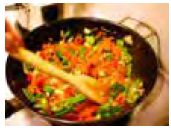
Advantages
·
Takes less time.
·
Simple technique.
·
Minimum oil is used
Disadvantage
· Constant attention is needed as there is chance of scorching or burning
6. Frying:
In this method, the
food to be cooked is brought into contact with a large amount of hot fat.
Frying is of two types namely deep get frying and shollow get frying.When food
is totally immersed in hot oil, it is called deep fat frying. Samosa, chips,
pakoda are examples of deep fat frying. In shallow fat frying, only a little
fat is used and the food is turned in order that both the sides turn brown. Eg.
Omelets, cutlets, parathas.

Advantages
·
The calorific values of fried food is increased since fat is
used as the cooking media.
·
Frying lends a delicious flavor and attractive appearance to
foods.
·
Taste and texture are improved
Disadvantages
·
Fried food especially deep fried food is difficult to digest and
has high calorific value. Excessive
·
consumption of fried foods are bad for health.
·
Can be a risk factor to develop life style diseaces.
c. COMBINATION OF COOKING METHODS
Braising
Braising is a combined
method of roasting and stewing in a pan with a tight fitting lid. Flavourings
and seasonings are added and food is allowed to cook gently. Food preparations
prepared by combination methods are :
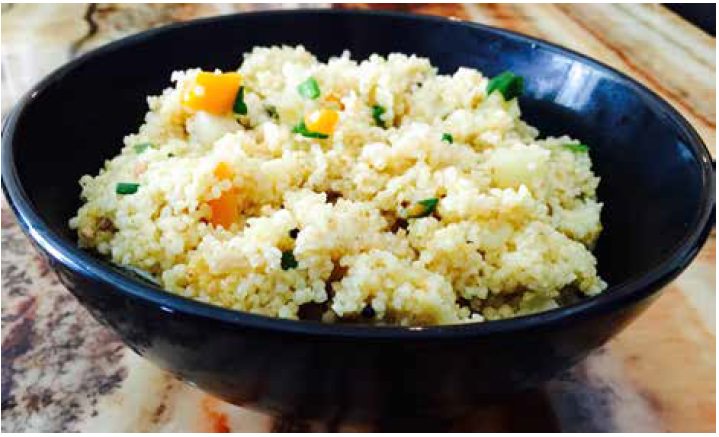
Other Methods of Cooking
1. Microwave Cooking:
Microwaves are
electromagnetic waves of radiant energy with wave lengths in the range of 250 x
106 to 7.5 x 109 Angstroms. It is a comparatively new method of cooking and
gradually becoming popular. In this method food is cooked by microwave
radiation. Water molecules in the food vibrate rapidly due to microwaves. The
heat generated in the process cooks the food.

Advantages:
·
It is a quick method of cooking.
·
Cooking time is reduced
· significantly as compared to other methods of cooking.
Disadvantages
·
It uses electrical energy and therefore may not be useful in
·
places where continuous electricity supply is not available.
·
It may dry up the food products.
II .Solar Cooking:
A solar cooker is a
device that changes the light energy of the sun to heat energy to cook food.
There are three main types of solar cooker:
Panel-type
A hybrid of reflector
and box-type solar cookers, using both a curved reflector and a cooking container
into which the food is placed. This combines the reflective properties of a
curved surface with the heat retaining properties of a container.
Parabolic type
A solar cooker that
uses reflective surfaces to collect, concentrate and direct the sun’s rays onto
the food being cooked.
Box-type (or oven-type)
A solar cooker that
uses plane reflectors (such as mirrors) to reflect radiation through a glass or
plastic window into an insulated cooking container. The container normally has
reflective sides and a black metal base.

Advantages
·
A solar cooker does not produce
·
smoke. It has low maintenance and practically no running cost.
·
It is an environment friendly method of cooking food.
·
Solar cooking can be successfully done in many parts of India.
Disadvantages
·
Solar cooker is used outdoors and works only when there is
plenty of sunshine.
·
Slow cooking process.
·
Cannot be used in the absence of sunlight’s in rainy seasons,
late evenings and nights.
Related Topics